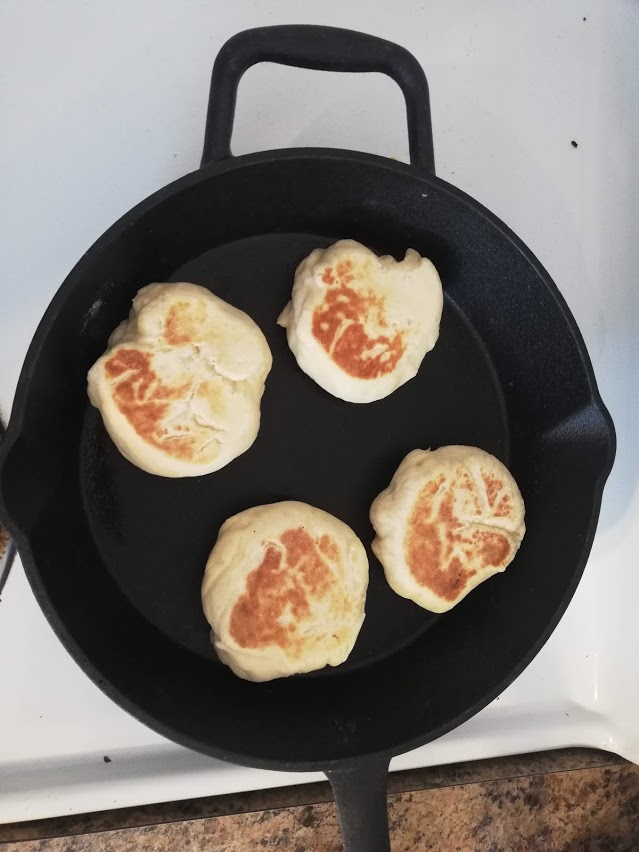Welcome back to another issue of “How Much Longer Can I Keep Using Relevant ELO Songs as Food Column Titles?”. The answer is evidently at least once more.
Scroll to the bottom of the page for a recipe for English muffins.
This year, I have stopped buying bread entirely, opting instead to make my own. Since the beginning of the term, I’ve baked a few wonderful French loaves, and a few subpar piles of dough out of which I begrudgingly made sandwiches. The recipes I used didn’t vary too much, so I was surprised when one loaf came out with lovely bubbles and another was as dense as your grandma’s fruitcake.
While it’s pretty easy to make a good dough, it’s exponentially harder to make it excellent. There are so many intricate little conditions that all must be just right in order to actually get the taste and texture you expect. Most of it comes down to the rise, and the rise depends on one main ingredient: the yeast.
Yeast (Saccharomyces cerevisiae) are single-celled, LIVING organisms, members of kingdom Fungi. They consume sugars and produce carbon dioxide as waste. This chemical process is alcoholic fermentation, and the gases expelled by the yeast are what makes bread rise.
Yeast production occurs in big fermenting tanks. A small sample of yeast is mixed with sugar as an energy source and left to ferment. Once the yeast fills the tank, it is centrifuged and further processed into different forms. The two common ones found at the average grocery store are active dry yeast and instant yeast. Active dry yeast is produced by drying and compressing the product into small granules, which should be rehydrated before using in the baking process. Instant yeast is made up of much smaller granules and can be added directly into dry ingredients.
Proofing, the process of testing if yeast is still alive and well, involves mixing the yeast into warm water and sugar. If the mixture gets frothy it indicates the yeast is still alive. I prefer using active dry yeast and letting it sit in warm water/milk for at least 10 minutes, as even though the proofing process isn’t necessary for either kind of yeast, I’ve found that the lighter airier loaf produced is worth the wait.
English Muffins
My most recent endeavour was English muffins. Many bread recipes will tell you to use a stand mixer and dough hooks to mix. The only mixer I have is my arm and a spoon, so this recipe won’t require any fancy gadgets, just some hands-on work and a can-do attitude. If you want a more authentic English muffin, you can sprinkle cornmeal on both sides of the muffins before the second rise.
Ingredients
- 2 cups milk
- 2 tbsp sugar
- Packet of active dry yeast (not instant)
- 4 tbsp melted butter
- 1 egg
- 5 cups flour
- 2 tsp salt
Recipe
- Warm milk and sugar in the microwave until warm, not hot.
- Stir in yeast and let sit for 10 minutes. The mixture should be frothy.
- Add melted butter and egg to the mixture and whisk until combined.
- Add flour and salt to a large bowl. Gradually pour in the milk mixture, stirring with a wooden spoon until just combined.
- Scrape down the sides of the bowl, then use your hands to knead the dough for about 5 minutes. It will start to get tough, then it will soften up.
- Once the dough has formed a smooth, slightly tacky ball, turn it out into a lightly oiled bowl. Cover with a clean tea towel and let rise for an hour in a warm place.
- Turn the dough out onto a lightly floured surface and gently knead it together.
- Separate and roll into balls of the desired size (this recipe can make around 16 larger muffins or 24 smaller muffins). Flatten each ball into a disc shape.
- Line 2 baking sheets with parchment paper and lightly dust with flour. Place the disks on the sheets, dust the tops with flour, cover with clean tea towels, and let rise for an hour.
- Preheat the oven to 325°F.
- Heat a very lightly oiled cast-iron pan over low heat. Lightly brown each side of each muffin (about 2 minutes per side).
- Put muffins back on the baking sheets and bake for 10-15 minutes.
- Remove from baking sheets once done and let cool on a cooling rack.
The Finished Product

Sources
https://redstaryeast.com/science-yeast/what-is-yeast/
https://www.ifst.org/lovefoodlovescience/resources/raising-agents-biological-fermentation





Leave a Reply